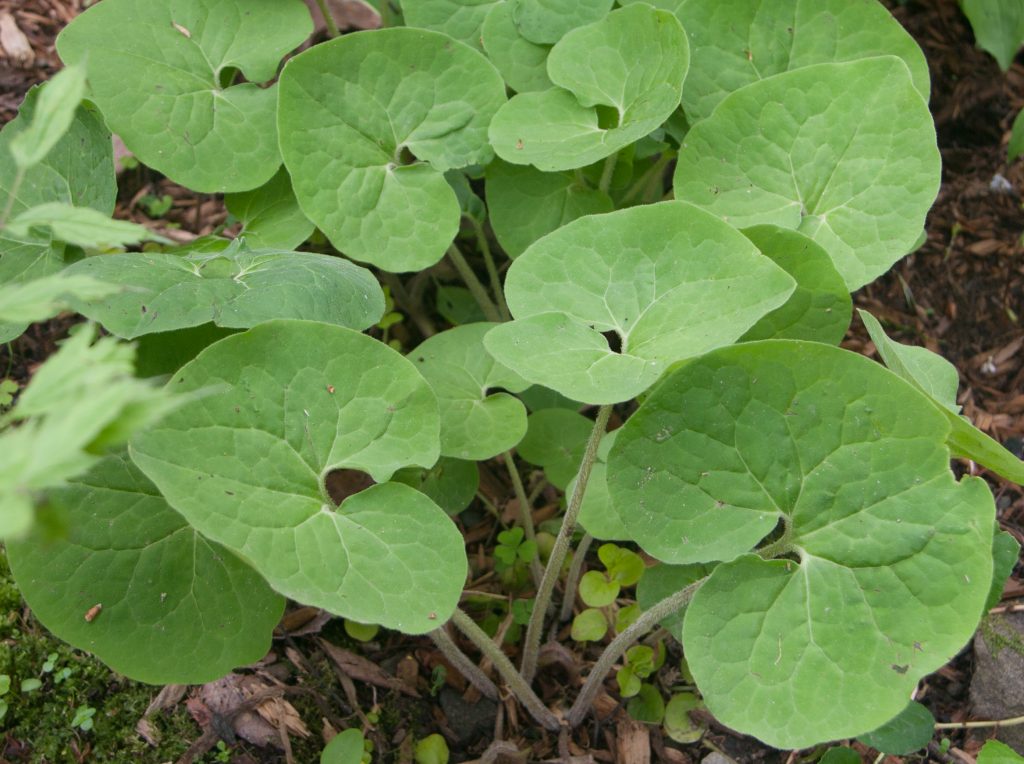
Our native wild ginger is a lovely, low maintenance ground cover perfect for a shady garden. It’s also one of my favorite wild spices.
There are two species of wild ginger native to North America: Asarum canadense in the East and A. caudatum in the West. Both have matte green, heart-shaped leaves and spread steadily but slowly in the landscape. The flowers are unusual in that they grow at soil level, tucked underneath the plant’s leaves. In early spring, push the foliage aside and check the base of the plants to find the dark, three-pointed blooms.
Wild ginger plants are connected by rhizomes that run just below the soil surface. It’s not unusual to discover vast hillsides covered with interconnected wild ginger. The rhizomes grow only an inch or two below the soil surface, and are relatively easy to lift out of the soil.
It’s the rhizomes that are the most flavorful parts of the plant, and fortunately, you can harvest them without killing the ginger. Using a shovel or trowel, gently lift a clump of plants and notice how they’re linked by the underground rhizomes. Sever a rhizome that connects two plants by making a cut near the base of each plant. Be sure to leave some roots intact at the base of each individual ginger plant. Then, replant the severed plants.
Late fall and early spring are the best times to harvest wild ginger, when the plants are dormant. At this point in their growth cycle, disturbing the root system won’t hurt the plant, but digging them up while the plants are in active growth could do some damage.
Bring the rhizomes back to your kitchen and give them a good scrub. They can be used fresh, or dehydrated and stored for later use. I usually dry and store enough rhizomes to get me through an entire year.
Wild ginger combines well with both savory and sweet dishes. While its flavor resembles that of tropical ginger, it has a darker, more complex flavor that I like even better. Finely chopped or ground in a spice grinder, the rhizomes can be used instead of traditional ginger in any of your favorite recipes. Try it with spice bush berries to give foraged flavor to dry rubs and baked goods. Wild ginger is wonderful in pear pies and apple crisps, in marinades, ginger bread or wild ginger snap cookies.
I’m often asked if wild ginger is safe to eat, because some people have heard that it contains aristolochic acid, a carcinogen that may cause kidney failure. If you’d like to know more about why I don’t worry about this, read Hank Shaw’s article for an excellent explanation. Hank and I disagree about the most flavorful part of the ginger plant, but we agree that in moderation it’s a very tasty wild herb.
Hey Ellen!!! I am so excited about this plant! I found some earlier this year and confirmed that it was in fact wild ginger. Today my husband and I went and picked some. It is growing like crazy at a public area near us. I’m excited to experiment! Thanks for your recipes and information!
That’s great, Katie! Please let me know what you do with it.
I dried some wild ginger rhizomes and they turned quite dark is this normal or a mold? Thanks
The rhizomes do darken. If you can scrape off the dark color, that could be mold. If you can’t scrape off the dark color, you’re probably fine.
Thanks Ellen for the response. Just harvested some more and will try this again. The ones I dried previously got nearly black and had an unpleasant odor…so did not think it was anything I needed to ingest. Hope I get it right this time, looking forward to using it with the spicebush berries also harvested today! Thanks again for the info!
Mine also turn very dark brown/black, but the smell is wonderful. I hope your next attempt succeeds!
Everything else I read on the internet says not to eat while Ginger it is toxic why do you say it’s not.?
tawnie2263@gmail.com
I think the better question is “Under what specific circumstances do these other sources say wild ginger can be toxic”! The potential toxins in Asarum species are not soluble in water. I don’t recommend infusing it in alcohol or vinegar, but water-based syrups and dehydrated/powdered stolons used as a spice are safe. It sounds like you’ve done some research already, but if you haven’t seen this article (https://honest-food.net/wild-ginger-edible-toxic/), you should read it! Hank has done the research. Most foragers I know (including myself) use ginger in reasonable amounts and prepared safely. The bottom line is, if you don’t feel safe eating it, don’t eat it. You get to chose what to put into your body. Btw, did you know that cinnamon can also be toxic if consumed in large quantities? Since we don’t usually chow down on plates full of cinnamon (or wild ginger!), it’s safe to use as a spice.